Having played Commander for over a decade, it’s easy to say that options for any given color identity have never been as plentiful as they currently are. Every year, we’re bound to see a cycle of two color ally and/or enemy commanders, and shard or wedge commanders at least once in a two year span. Before Commander 2011, this was by no means the case. The most popular commanders were cards that had been tuned for competitive formats and rose to the top because they facilitated what the color identity represented at that time. But it eventually begged the question: how have the different color identities of Commander shifted over the last decade and half?
Inspiration for this topic came to me around the time I was writing my Commanders of Commander 2013 article. But now having made my way through most of the mainline Commander products, the instinct to write this article was beginning to rear its head even more. As I would analyze the then-current placement of each commander, I would sometimes reflect on how restrained the design space was in those early years. Three-color generals have always been extremely popular, representing pillars of the format, with only the five color good stuff deck outpacing their respective power levels. But the makeup of those pillars has shifted in ways I didn’t realize until sitting down to analyze this topic.
Today, we will be looking at the five shards for their current and past popular commanders. While it may be true the popularity of each of my selections is based partially on my own biases; I assure you, if they were not the most popular, they were neck-and-neck in a top two. We will return in a few weeks to look at the Wedge commanders, in what should be just as interesting of a journey. Because my journey into Commander roughly started in 2010, there is an undeniable bias towards Shards of Alara’s legendary creatures. A bias which is going to dominate this entire discussion. But those were often the best options we had at the time and in some cases, the next options moving backwards chronologically came from the Invasion block eight years prior. Truly different times.
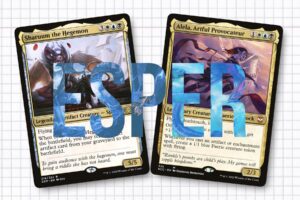
The Commanders of Esper – Sharuum and Alela
Esper
Our look at Esper is going to start with Sharuum the Hegemon, who led an archetype which was hard to ignore at that time. Because of Sharuum, I still envision white-blue-black as an artifacts-matter combo deck, armed with Disciple of the Vault or Master Transmuter combos. The deck would chug along accruing value, until finally getting finishers like Sphinx of the Steel Wind or Steel Hellkite out to push those last few points of damage through.
I don’t want to overlook the impact Zur the Enchanter had on the format of fledgling Commander either. But I would argue that he was less representative of what Esper was as a color identity. More an example of how tuned Commander could be. He might seem benign now, but Zur represented a aura-based stax, rivaled only by Grand Arbiter Augustin IV. Certainly a testament to early Commander, and the only general from the time period to seemingly stand the test of time.
From a surface level, Alela, Artful Provocateur may not seem like a huge departure from Sharuum, as she still encourages artifacts as an important component of her deck. But once you look at the makeup of an Alela deck, you begin to realize it is much more of a skies deck using artifacts and enchantments as a catalyst, in the same way The Locust God uses card draw to build an army. Esper is now much more a go-wide tokens deck, monopolizing fliers as instead of lowly elves or goblins.
So what perceptions of Esper can we infer from these popular generals? Even when I try to divorce myself from the association I make with this color combination, it’s weird to think Esper is no longer dominated by exclusively artifacts-matter decks. I know it’s largely due to Breya, Etherium Shaper entering the format in 2016, but besides newcomer, Urza, Chief Artificer, the top ten Esper commanders care little for artifacts exclusively. I think Alela, Artful Provocateur has become the face of the shard, due to her reliance and the pressure she can put on a table.
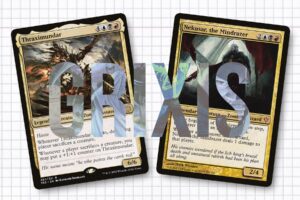
The Commanders of Grixis – Thraximundar and Nekusar
Grixis
Looking back, the offerings for Grixis and Jund players seems laughable with hindsight. In the example of Thraximundar, I feel like the deck was being carried on name alone. While there is undeniable synergy between cards like Fleshbag Marauder, Grave Pact, and Diabolic Edict, this was only going to get you so far. Thraximundar was an expensive creature in an era where your commander was going to be removed at least two or three times in most games. Because of this, I can only imagine the zombie assassin was predominantly a late-game creature which possessed a bit of inevitability once your opponent was left in a top-decking situation.
I am actually surprised Nekusar, the Mindrazer has seen the undeniable resurgence it has. Nekusar was an immensely popular commander in the year following his release, but at some point the linear nature of the deck was enough for interest to wane. I can’t even be sure what exactly would have caused this triumphant return, besides the printing of Harmonic Prodigy to double Nekusar’s trigger or Obosh, the Preypiercer drawing attention as early as Spring 2020. Either way, I have a personal soft spot for this commander, being one of my favorite decks to pilot of all time. I only wish I had invested in Sheoldred, the Apocalypse, because I don’t know if the deck will feel complete without it now.
So what perceptions of Grixis can we infer from these two popular generals? While it might not necessarily be my most desired gameplay pattern anymore, playing contemporary Grixis means playing spells. Nekusar is open-ended, but tells you what kind of spells you’re looking to cast to win. This juxtaposition against the nondescript sacrifice-matters of Thraximundar really highlights how creature dependent Commander was at the time. Thrax was good in the same way that Condemn or Ether Well could be good, they were all helping to remove creatures in varying ways, this one happened to come with commander damage.
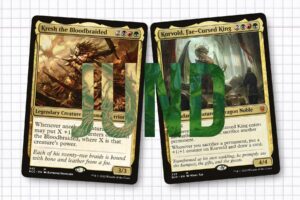
The Commanders of Jund – Kresh and Korvold
Jund
I was unsure exactly how to classify early Jund as I was putting this article together. It caused some introspection about the weird placement it occupied prior to Commander 2013. For every Karrthus, Tyrant of Jund or Kresh the Bloodbraided deck, you legitimately might see a deck led by a Chronicles printing of Vaevictis Asmadi. Before Prossh, Skyraider of Kher, Jund felt like a good stuff deck that didn’t rely on its commander outside of having a dedicated creature to deal combat damage. Obviously Karrthus represented a dragons deck and their enters the battlefield trigger carried more weight at the time. But Kresh might as well have been cribbing notes from Thraximundar about how to properly motivate the table into sacrificing their creatures.
Ironically, Korvold, Fae-Cursed King feels like a natural evolution of Kresh the Bloodbraided in a world dominated by Commander. Korvold turns the focus on its pilot to provide fodder. This is a response to the evolution of the format, graveyards have become a second hand. Giving your opponents a sacrifice outlet is far more dangerous than it would have been ten years ago. Korvold allows you to benefit, not only through card advantage and a larger commander, but the multitude of death triggers you choose to put into your deck. This provides more agency in a format which increasingly requires it.
So what perceptions of Jund can we infer from these two periods of the format’s history? What’s fascinating to realize is Jund may not have had a unified feeling ten years ago, and while I wouldn’t say it has necessarily built towards a definitive identity now, it seemingly embodies a feeling of “greatness at any cost” which most people would associate exclusively with black. Jund has certainly become a color identity willing to embrace self-sacrifice and still maintain the home for large creatures. Jund is also very popular, with Korvold being the most popular commander of all the legendary creatures being examined today; presently the tenth most popular commander over all.
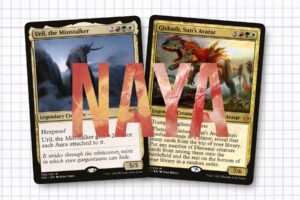
The Commanders of Naya – Uril and Gishath
Naya
Uril, the Miststalker may have been the most synonymous commander in the format, as it came into its own as the face of Voltron decks. It was because of Uril I learned about auras like Ancestral Mask and Shield of the Oversoul, showing off how much political power one creature could have. In those days, everyone seemed to have a Sharuum deck of varying power level, but the Uril deck was always something to worry about and rarely got brought out for more than one game in a night. The problem stemmed from how hard it was to combat Uril at the time. It eventually led to an understanding where any deck which could pack Back to Nature or Tempest of Light really ought to, and everyone else should bring Nevinyrral’s Disk.
There are times when I’m shocked how Gishath, Sun’s Avatar has proven to be more popular than Zacama, Primal Calamity. But of course, the former works far better as the leader of the dinosaur deck, with Zacama being a good stuff Naya commander. Nevertheless, Gishath is a worthy face of the Naya color identity in 2023. The typical Gishath deck is going to be packed with ramp spells and payoff dinosaurs, such as Etali, Primal Storm and Polyraptor. These decks are straightforward and fun to pilot.
So what perceptions of Naya can we infer from these two popular generals? I would wager to say that Naya as a shard has proven to be the home for ramping into big creatures. This could be seen even back in the day through Mayael the Anima. It has solidified once dinosaurs were recognized as a creature type. More so, I think Uril may have been popular because of how distinctive he is, but the color identity has moved away from auras for the most part, with Palladia-Mors, the Ruiner and Mazzy, Truesword Paladin being notable returns to the archetype within Naya over the last five years.
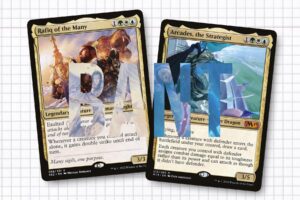
The Commanders of Bant – Rafiq and Arcades
Bant
While Uril, the Miststalker was emblematic of what a traditional voltron looked like, Rafiq of the Many was looking to fill the table with as many exalted creatures as possible and make a voltron out of the best creature on hand. The deck often revolved around key effects using or tertiary to exalted; Rafiq granting double strike, Finest Hour enabling a second attack step, and Stoic Angel fighting against go-wide decks. This strategy resulted in any creature, even now-overlooked creatures like Trygon Predator[/mtg_card, being extremely impactful. But the most important trait at the core of a Rafiq deck was just how many creatures it would play, making a [mtg_card]Day of Judgment its Achilles’ heel.
Arcades, the Strategist has a surprising place in this list, but in a way different from Nekusar, the Mindrazer. Where Nekusar was a popular commander who drifted into obscurity, before seeing a recent resurgence, Arcades has remained a steady Bant commander since their printing. One of the most unique decks in the larger Commander meta, Arcades invites its players to invest into creatures with defender and high toughness to win games. One of my favorite innovations has to be Tetsuko Umezawa, Fugitive, a legendary creature I had not considered the synergy of until now. I love it. While a typical Arcades deck will not take on a lot of new cards in a given year, it’s easy to see the appeal they get from their target audience.
So what perceptions of Bant can we infer from these two popular generals? It’s been a wild ride, for sure. While Phelddagrif may have shared some of the space with Rafiq, the Bant of the past felt a lot more like where Naya has gone in the era of the Cabaretti of New Capenna. Now the most popular commander in the color identity is a dragon that draws cards based on you playing creatures with defender. And those creatures designed not to attack are your source of damage. It’s strange and I love it. I think it also speaks to how important card advantage has become as a trade off to placing importance on a synergy that promoting having one big attacker.
When I set out to start writing this article, I thought the crux of what I was going to be examining was how differently creature design has changed as Commander has come more into focus over the last decade. But a detail I had not considered until writing was realizing how much the archetypical makeup of each of these five color identities has monumentally shifted without me realizing. From a historical perspective, it is rather fascinating and certainly eye-opening. I knew creatures had become value engines, but I think I forgot how restrained the legendary creature design used to be. In our next installment we will be taking a step away from Magic, before returning to this subject to examine the five wedges and how they have shifted in the last decade. Thank you for reading.
Ryan Sainio (he/him) is a Graphic Designer exploring the Commander format and Magic history on a regular basis. Notable decks that value flavorful and fun gameplay over competitively optimized decks include Shattergang Eldrazi, Doran Soul Sisters, and Chatterfang ProsBloom.
MTG Content Creator Awards 2022 nominee: Format Specialty Writing & Excellence in Writing Overall

